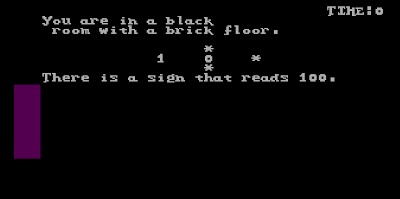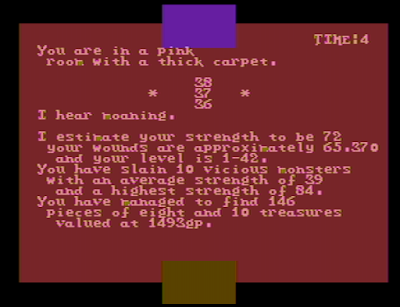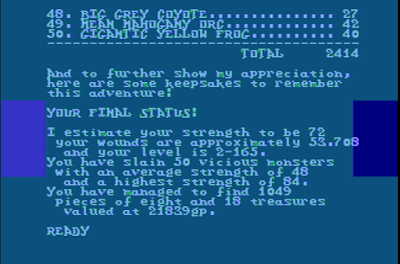Tuesday, September 22, 2020
Ep 31: No School Like The Old School Is Live!
Monday, September 21, 2020
Camouflaging The Imperial Guard Armoured Company
Not many updates but I've been slogging through the camouflage on the Armoured Company these past weeks. The base colors and shading are done, I'm now onto tidying. That should finish up this week and hopefully I can start on the highlights.

The green and tan each get a base, wash, neaten up, and two highlights. The black and metal get a wash and a highlight or two, depending on how they look.



I also painted this guy up over the course of a couple hours this week. He's a battle wizard from my last Kickstarter. He's meant to be a gold wizard/alchemist.


Saturday, September 12, 2020
Game 378: Goodcode's Cavern (1982) And Romero/Carmack Corrections
Gebelli Software (publisher)
 |
| Stepping into the first room. |
 |
| This room is pink with a thick carpet and there's moaning. |
 |
| Hot tacos indeed. Although I suspect if I saw a blue grizzly bear, I'd start blaming something else I got in Mexico. |
 |
| Finding a "nickel headband" and then checking my status. |
 |
| The mammoth russet vampire was a little too much for me, so I zapped him with the wand. I'm glad I did, because the colossal gold knife was worth a lot of money. |
 |
| A demon convinces me to pay reparations. |
 |
| No, but you can resurrect me. |
 |
| Room 80 on Level 1. |
 |
| The winning screens. |
 |
| I have no idea what's happening here. |
1991 was a major transition year for Carmack and his new partner, John Romero. At the age of 20, Carmack had gotten a job two years prior at Softdisk, largely on the strength of his Dark Designs series. But he and the other developers grew to despise the sweatshop-like atmosphere of Softdisk and the monthly programming demands. He and Romero began moonlighting by selling their own games--principally the Commander Keen series--as shareware on bulletin board services. When Softdisk found out about these games, and that the pair had been using the company's computers to write them, both threats of a lawsuit and offers of a contract followed. The messy result was that Carmack and Romero left the company but agreed to continue to produce one game every 2 months for Softdisk's magazines. Thus, a couple years later, after the team had changed the gaming world forever with Wolfenstein 3D and DOOM, you see them credited on the occasional diskmag title like Cyberchess and Dangerous Dave Goes Nutz!
- I was a year late; 1990 was the year most of this happened. Romero worked at Softdisk prior to Carmack and was actually the one who hired Carmack, not because of Dark Designs but because of a tennis game plus his obvious facility with programming.
- Romero and Carmack loved working at Softdisk and only left because it was the wrong sort of publisher to take advantage of the horizontal scrolling technology that the duo would use in Wolfenstein 3D and DOOM.
- It was actually the president of Softdisk, Al Vekovius, who suggested that Carmack, Romero, and Tom Hall start their own company. There were no lawsuits and no threats; Carmack and Romero kept working for Softdisk for a year to avoid leaving the company in a lurch.
- The reason Carmack and Romero are credited on so many Softdisk titles stretching into the mid-1990s is that those titles used technology and code that Carmack and Romero had created. They otherwise had no involvement in games like Cyberchess and Dangerous Dave Goes Nutz!
Sister Tempest By Joe Badon, Movie Review
Anne Hutchinson promised Karen, her younger sister, when they were orphaned that she would take care of her and always be with her till the day they died. As they grew up, Anne worked hard to be the parent she knew Karen needed. They grew older and grew apart as Karen developed a relationship with a young man. He had his problems and Anne didn't like him or what it would mean for Karen. They argued and Karen left, vowing to never return. That night Karen's boyfriend was murdered and Karen was missing.
That is the starting premise of Sister Tempest,which is written and directed by Joe Badon (IMDb link). What happens after is a rollercoaster ride through Anne's psyche. As she deals with the trauma of her missing sister, her internal tempest swirls.
 |
The Story Side
Sister Tempest is summarized with the following.
"Anne Hutchinson's troubled relationship with her missing sister is under alien tribunal. Meanwhile, her new roommate's mysterious illness causes her to go on a cannibalistic killing spree."
I'm not going to say much about the plot. The story constantly weaves back on itself with flashbacks and flash-forwards, along with jumps through dimensions, as Anne recites her tale of events to a panel of "judges." They want to know the story from her point of view so they can get to the truth as Anne perceives it. And, that is the real question as the story unfolds.
Badon tells his story of Anne in an art house style. Throughout the movie, scenes are cut into and out of to produce chapters set apart by short scenes giving foreshadowing to the events about to unfold. This is a film that needs to be watched carefully. The story seems rough and a little hard to follow at first. But, as the chapters unfold, the pieces of the puzzle of Anne's stormy mind settles.
 |
The Production Side
I first met Joe Badon at the FilmQuest Film Festival (website) when he was screening his first feature film, The God Inside My Ear(IMDb link). If you liked his first film, you will enjoy Sister Tempest. Both have the aspect(?) of mental self-discovery.
Badon provides a lot of little tidbits in his film. Along with the foreshadowing within the chapter headers, there are a number of symbols, metaphors, and tokens used to bring the story full circle from the opening scenes through the "flashback" telling of the story by Anne to the final scene of discovery. It is because of these elements woven into the plot that it would be unfair to give an outline without giving away the end.
Sister Tempest is a low budget film. Instead of detracting from the film, if allowed, the level of technical special effects adds to the story. We are being told the story through Anne's viewpoint, her perception of events, her reality, which is not a good place. The special effects are reminiscent of older movies and Sister Tempest includes scenes from sci-fi, horror, and other classic films. Many times when people think of low budget, they think there isn't much talent involved. That is not the case.
The cast of Sister Tempest has a broad range of experience. The combination of talent provides depth for the style and budget. Two of the main roles are Anne and her new roommate after Karen leaves, Ginger.
Anne Hutchinson is played by Kali Russell (IMDb link). This is her second listed credit and her first feature film. Her portrayal of Anne gives us a woman facing a breakdown. Everything she has worked to maintain in her life for her and her sister is gone. The sense of loss is palpable. She brings this out in her dealings with the events of her daily routine and when dealing with new possibilities and other characters. For a first major role, I like what Kali Russell brings to the story and to the screen.
Ginger is portrayed by Linnea Gregg (IMDb link), who is returning to work with Joe Badon after playing the lead role of Elizia in The God Inside My Ear. She also brings an insight to the mental stresses taking place and how they are dealt with. She provides an excellent counterpoint to Russell's Anne. They show their connection to each other on screen and allow the story to grow.
Sister Tempest is prepared to be on the film festival circuit. At the time of this review, there was no mention of where Sister Tempest will be screened.
I recommend Sister Tempest for people who want to see a film that is different, thought provoking, and requires you to pay attention to what is happening on the screen.
You can find out more about Sister Tempest on IMDb (IMDb link).

I'm working at keeping my material free of subscription charges by supplementing costs by being an Amazon Associate and having advertising appear. I earn a fee when people make purchases of qualified products from Amazon when they enter the site from a link on Guild Master Gaming and when people click on an ad. If you do either, thank you.
If you have a comment, suggestion, or critique please leave a comment here or send an email to guildmastergaming@gmail.com.
I have articles being published by others and you can find most of them on Guild Master Gaming on Facebookand Twitter(@GuildMstrGmng).
Thursday, September 3, 2020
Monthly Progress Report For My Twitch Channel, FuzzyJCats, Nov 25 Through Dec 24
During this month of streaming, I continued to work on improving the usual chatting and gaming at the same time, and not using filler words, though I noticed I constantly slip into using a lot of filler words as they help to fill dead air.
I was also trying to find out how we can tell if we're entertaining. Certainly watching your VoDs help you notice if you're articulate or not, if you move around too much such that you're off the facecam, but I still can't tell if my streams are entertaining.
However, I started having an inkling as to what's entertaining to viewers this month. Since the entertainment is in real-time, and people are chatting, like with everything, people find you very interesting if you ask about them and talk about their issues. This is try-hard but cbenni.com can let you review your logs so you can remember what your viewers say, so when they show up the next time, you can ask them about that specific thing.
For instance, if they mention that they're starting a new job, you can ask them how work is coming along, if they like their new boss, coworkers, and so on and so forth.
So another try-hard method is after each stream, I have been more or less writing these topics to talk about when the viewer shows up next.
Again, this is very try-hard, but it can help not only make your chat more entertaining for specific viewers, but with these topics on hand, it will help reduce dead air.
Aside from the usual goal of chat and gaming ratio, working on dead air, and removing filler words while streaming, improvements to be made is to be more aware of my viewers so I can ask them about issues next stream.
The How of Happiness Review




